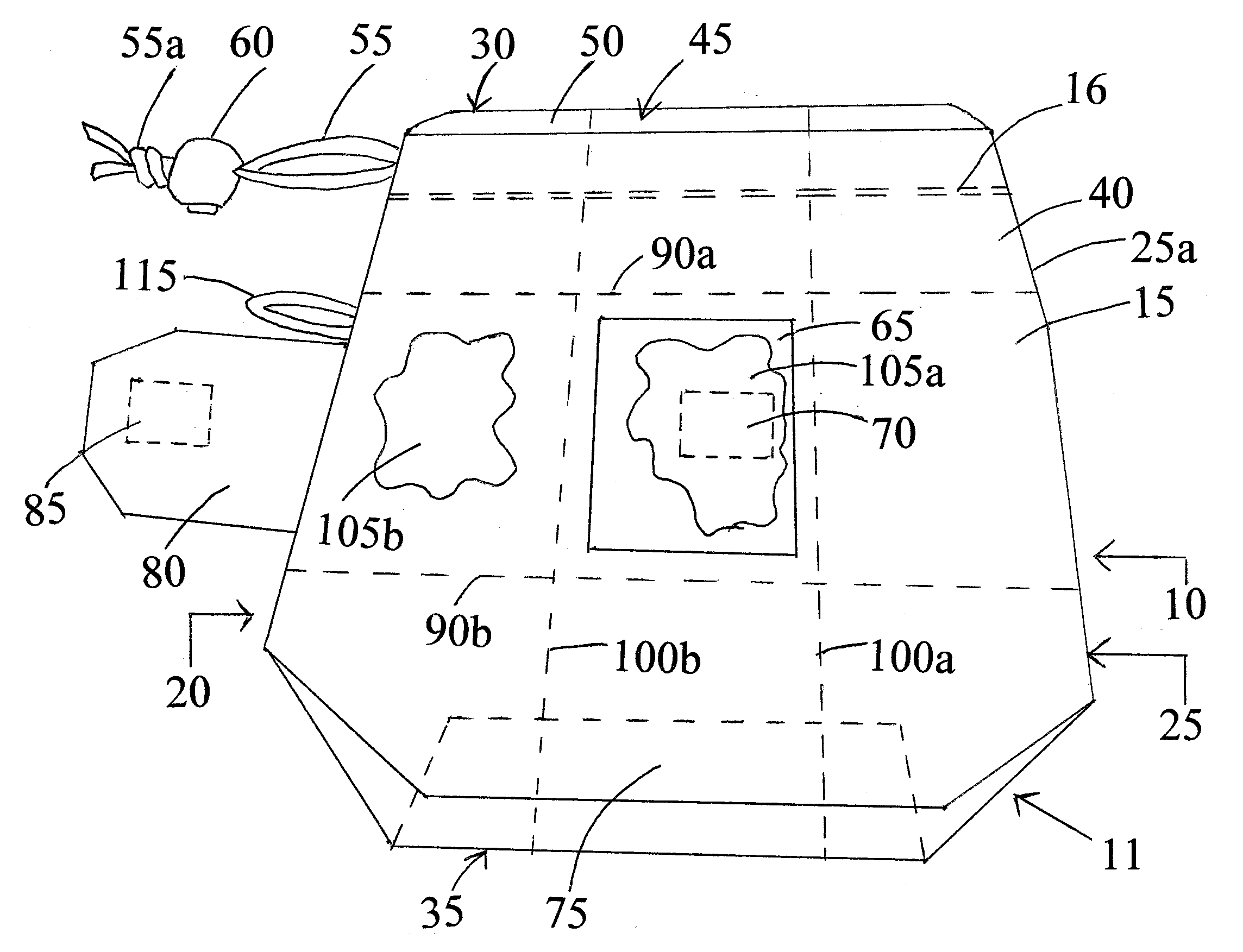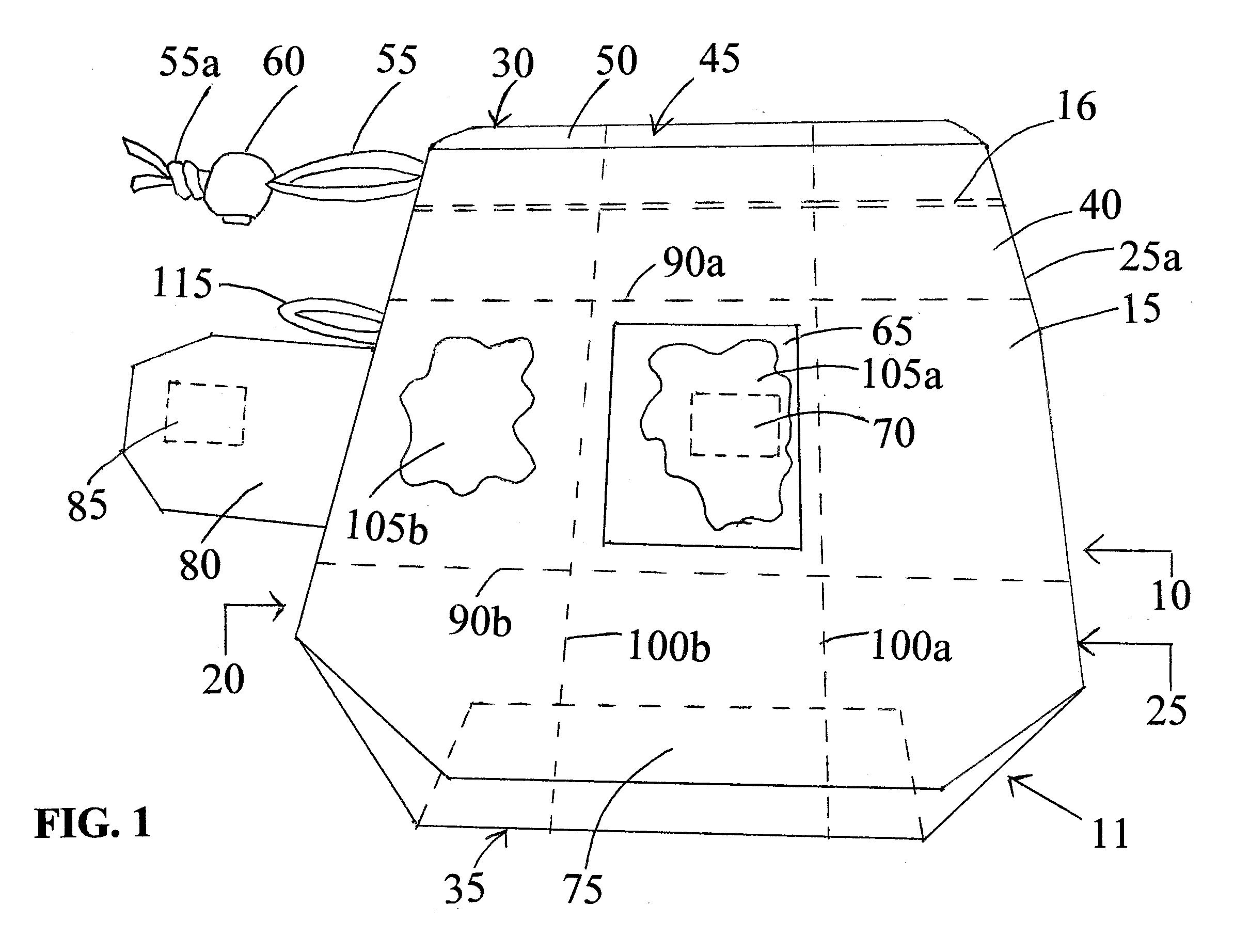However, current bags present several problems during the process of attempted reuse.
The most prevalent difficulties people have with reusable bags are encountered before or after use because current bags lack an integral closing mechanism that keeps a bag securely intact during the time they are attached to, and removed from, items while they are stored and transported for use.
The lack of an appropriate closing mechanism impacts a bag's ease of storage, transport, access, identification, condition,
visibility and the ability to stay securely intact.
Inconvenience with all, or each, of these factors may cause a person to make a choice to use a single or limited use bag instead of a reusable bag.
Loosely left bags, which are unsecured, may be dirtied, damaged, may splay-out, or not be located at the time of next use.
Bags that have been crunched, squished, and stuffed into a storage or transport vessel may be wrinkled, unsightly, and with an unkempt appearance when removed, and further storage in such a condition may reduce the useful life of the bag and age it prematurely.
A rolled bag may be unwieldy to roll, unroll, and re-roll, and difficult to keep intact in the rolled position making it impractical for storage or transport in the collapsed or rolled position.
Additionally, a rolled bag may be difficult to store because of its cylindrical shape, density, bulk, and size which may not allow it to be easily compressed so as to fit in a pocket, purse, backpack, or some form of carrying satchel, and, if it does fit, it may take up more space than desirable.
Many known reusable bags do not have an integral locking and unlocking mechanism for preventing the bag from splaying out, opening unintentionally, and
snagging on other items, for example.
The lack of an integral locking and unlocking mechanism creates inconvenience to the bag user, who must attempt to re-close it and hope it stays in the desired (closed) position.
Further, it is desirable to have the locking and unlocking mechanism as an integrated piece of the bag rather than as a separate securing mechanism (such as a
rubber band, strap, belt, and the like), which is prone to loss and inadequately maintains the bag in the folded or stored position.
A separate transport or storage vessel may hamper reuse of a bag.
A bag's owner may not want to hand carry a separate and bulky storage or transport vessel along with a purse or other items while shopping.
If a storage and
transport system is inconvenient and undesirable it may not be utilized, making
accessibility a potential problem at the point of next use.
Locating a rolled or stuffed bag contained within a larger vessel, which carries multiple items, may be frustrating.
Accessing a desired bag may be difficult when it is one of many bags stuffed into a confined storage or transport vessel as the compression of multiple bags may not allow for expeditious viewing, comparison, selection, or retrieval.
Repacking the unselected bags into the larger vessel's cavity may be another inconvenience for a bag owner.
If access to a desired reusable bag is limited and inconvenient, a frustrated bag owner may choose not to reuse it.
A rolled up or stuffed bag may cause difficulty in identifying the bag as belonging to a certain individual or group with personal or general information, or as an advertisement for a team or business with logos or other identifying marks.
Many reusable bags look similar and in a setting where many people are using reusable bags, it may be difficult to identify whose bag is whose.
A bag which has been crunched or left loosely around is likely not to be valued as highly as one that has been well taken care of and, the bag may end up underfoot and dirty, spilled upon, damaged, thrown away, or lost which makes it less likely to be reused.
This is because a bag's owner, and others, will see the carried bag's poor condition as looking “tacky” or so unattractive as to make the bag's carrier the owner of something unkempt, dirty, or otherwise undesirable.
Because our physical appearance and what we wear and carry with us largely defines us as individuals to society and the public at large, and most people would find it undesirable to be seen as unkempt, then a bag whose condition is such is unlikely to be reused.
When removed they may end up in a crunched and wrinkled condition with limited options for rectifying this problem.
Many reusable bags are manufactured using fabrics and printing methods, which may not tolerate
high heat; and as such, may not be ironed.
As a result, many reusable bags may not look fresh after being crunched, stuffed, twisted, dirtied, or damaged prior to the next reuse opportunity.
The poor appearance of a bag may limit the number of times an owner may want to reuse it, in opposition to the goal for a reusable bag.
 Login to View More
Login to View More  Login to View More
Login to View More 


